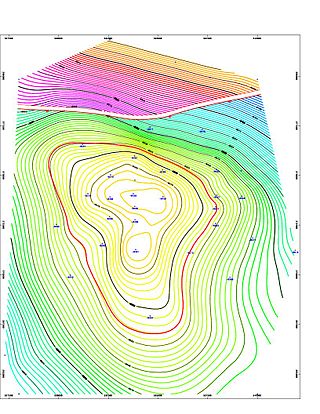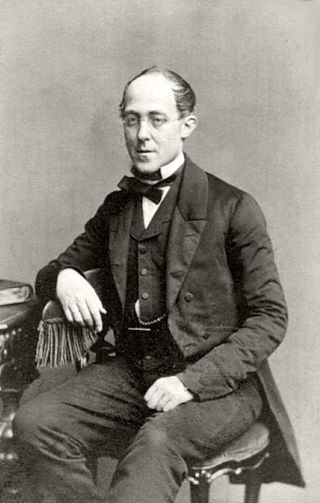Geostatistics is a branch of statistics focusing on spatial or spatiotemporal datasets. Developed originally to predict probability distributions of ore grades for mining operations, it is currently applied in diverse disciplines including petroleum geology, hydrogeology, hydrology, meteorology, oceanography, geochemistry, geometallurgy, geography, forestry, environmental control, landscape ecology, soil science, and agriculture. Geostatistics is applied in varied branches of geography, particularly those involving the spread of diseases (epidemiology), the practice of commerce and military planning (logistics), and the development of efficient spatial networks. Geostatistical algorithms are incorporated in many places, including geographic information systems (GIS).

Geologic modelling,geological modelling or geomodelling is the applied science of creating computerized representations of portions of the Earth's crust based on geophysical and geological observations made on and below the Earth surface. A geomodel is the numerical equivalent of a three-dimensional geological map complemented by a description of physical quantities in the domain of interest. Geomodelling is related to the concept of Shared Earth Model; which is a multidisciplinary, interoperable and updatable knowledge base about the subsurface.

The Zanclean is the lowest stage or earliest age on the geologic time scale of the Pliocene. It spans the time between 5.332 ± 0.005 Ma and 3.6 ± 0.005 Ma. It is preceded by the Messinian Age of the Miocene Epoch, and followed by the Piacenzian Age.

The Cisuralian is the first series/epoch of the Permian. The Cisuralian was preceded by the Pennsylvanian and followed by the Guadalupian. The Cisuralian Epoch is named after the western slopes of the Ural Mountains in Russia and Kazakhstan and dates between 298.9 ± 0.15 – 272.3 ± 0.5 Ma.
The Aquitanian is, in the International Commission on Stratigraphy's (ICS) geologic timescale, the oldest age or lowest stage in the Miocene. It spans the time between 23.03 ± 0.05 Ma and 20.43 ± 0.05 Ma during the Early Miocene. It was a dry, cooling period. The Aquitanian succeeds the Chattian and precedes the Burdigalian.
The Burdigalian is, in the geologic timescale, an age or stage in the early Miocene. It spans the time between 20.43 ± 0.05 Ma and 15.97 ± 0.05 Ma. Preceded by the Aquitanian, the Burdigalian was the first and longest warming period of the Miocene and is succeeded by the Langhian.
The Langhian is, in the ICS geologic timescale, an age or stage in the middle Miocene Epoch/Series. It spans the time between 15.97 ± 0.05 Ma and 13.65 ± 0.05 Ma during the Middle Miocene.
The Santonian is an age in the geologic timescale or a chronostratigraphic stage. It is a subdivision of the Late Cretaceous Epoch or Upper Cretaceous Series. It spans the time between 86.3 ± 0.7 mya and 83.6 ± 0.7 mya. The Santonian is preceded by the Coniacian and is followed by the Campanian.
In the geologic timescale, the Kimmeridgian is an age in the Late Jurassic Epoch and a stage in the Upper Jurassic Series. It spans the time between 154.8 ±0.8 Ma and 149.2 ±0.7 Ma. The Kimmeridgian follows the Oxfordian and precedes the Tithonian.
Geomathematics is the application of mathematical methods to solve problems in geosciences, including geology and geophysics, and particularly geodynamics and seismology.

David Bierens de Haan was a Dutch mathematician and historian of science.

The International Association for Mathematical Geosciences (IAMG) is a nonprofit organization of geoscientists. It aims to promote international cooperation in the application and use of mathematics in geological research and technology. IAMG's activities are to organize meetings, issue of publications on the application of mathematics in the geological sciences, extend cooperation with other organizations professionally concerned with applications of mathematics and statistics to the biological sciences, earth sciences, engineering, environmental sciences, and planetary sciences. IAMG is a not for profit 501(c)(3) organization.

Vera Pawlowsky-Glahn is a Spanish-German mathematician. From 2000 till 2018, she was a full-time professor at the University of Girona, Spain in the Department of Computer Science, Applied Mathematics, and Statistics. Since 2018 she is emeritus professor at the same university. She was previously an associate professor at Technology University in Barcelona from 1986 to 2000. Her main areas of research interest include statistical analysis of compositional data, algebraic-geometric approach to statistical inference, and spatial cluster analysis. She was the president of the International Association for Mathematical Geosciences (IAMG) during 2008–2012. IAMG awarded her the William Christian Krumbein Medal in 2006 and the John Cedric Griffiths Teaching Award in 2008. In 2007, she was selected IAMG Distinguished Lecturer.
During the 6th International Workshop on Compositional Data Analysis in June 2015, Vera was appointed president of a commission to formalize the creation of an international organization of scientists interested in the advancement and application of compositional data modeling.
Daniel Francis Merriam was an American geologist best known for fostering the development of quantitative modeling in geology after the advent of digital computers. He first joined the Kansas Geological Survey in 1953, initially working under the direction Raymond C. Moore to have a more accurate knowledge about the geology of the state. His fascination with the new possibilities offered by computers started ten years later while working with John W. Harbaugh at Stanford University as Visiting Research Scientist. In the following seven years, he was active organizing colloquia and as editor of the Computer Contributions, who saw 50 publications in the series by pioneers in the new field. Merriam accepted the position of Chairman of the Department of Geology at Syracuse University in 1971 and moved to the same position at Wichita State University in 1981, coming back to the Kansas Geological Survey in 1991 to retire in 1997, remaining as an Emeritus Scientist.
Dirk de Waard was a Dutch-born American geologist. He was a professor of geology at Syracuse University.
Johannes "Johan" Bouma is a Dutch soil scientist. He worked at the Netherlands Soil Survey Institute from 1975 to 1983 and was professor of soil science at Wageningen University and Research Centre between 1983 and 2002.
Gerard Isaäc Lieftinck, known in print as G.I. Lieftinck, was a Dutch academic specialising in medieval European manuscripts.
Isaäk Martinus van der Vlerk was a Dutch paleontologist and geologist who worked in Dutch Indonesia where he was involved in stratigraphic studies based on foraminifera. He applied morphometric studies, examining curvature in foraminifera as a criterion, for determining geological ages of strata.

Felix M. Gradstein is a Dutch-Canadian academic and a pioneer in quantitative stratigraphy and geologic time scale. At the University of Utrecht, he studied paleontology and stratigraphy, obtaining his Ph.D. taking a novel biometrical approach in micropaleontology, under the supervision of Professor CW Drooger. In 1976, after working two years for an oil company in Calgary, Canada, he joined the Geological Survey of Canada in its eastern division at the Bedford Institute of Oceanography in Nova Scotia. During his research there, he was instrumental in developing a novel quantitative method for the analysis of stratigraphic events. In 1992 Felix moved to Norway where he currently has an office at the University of Oslo and is Visiting Research Fellow at, University of Portsmouth, UK. From 1985 - 1989, he was chairman of International Geoscience Project (IGCP) 181 on Quantitative Stratigraphy. From 2000 to 2008 he was chair of the International Commission on Stratigraphy (ICS) and in 2010 was instrumental in founding the Geologic Time Scale Foundation. For his fundamental work concerning the Geologic Time Scale, geochronology in general, quantitative stratigraphy, and micropaleontology, the European Geosciences Union awarded him in 2010 the Jean Baptiste Lamarck Medal. Prof. Gradstein, a world-renowned stratigrapher discussed debates over the Geologic Time Scale with the Anthropocene working Group.
Walther Schwarzacher was an Austrian geologist best known for his research in quantitative stratigraphy. He was a Corresponding Member of the Division of Mathematics and the Natural Sciences of the Austrian Academy of Sciences and the second recipient of the William Christian Krumbein Medal, the highest award of the International Association for Mathematical Geosciences (IAMG).







